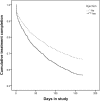Buprenorphine/naloxone and methadone maintenance treatment outcomes for opioid analgesic, heroin, and combined users: findings from starting treatment with agonist replacement therapies (START)
- PMID: 23739025
- PMCID: PMC3711351
- DOI: 10.15288/jsad.2013.74.605
Buprenorphine/naloxone and methadone maintenance treatment outcomes for opioid analgesic, heroin, and combined users: findings from starting treatment with agonist replacement therapies (START)
Abstract
Objective: The objective of this secondary analysis was to explore differences in baseline clinical characteristics and opioid replacement therapy treatment outcomes by type (heroin, opioid analgesic [OA], or combined [heroin and OA]) and route (injector or non-injector) of opioid use.
Method: A total of 1,269 participants (32.2% female) were randomized to receive one of two study medications (methadone or buprenorphine/naloxone [BUP]). Of these, 731 participants completed the 24-week active medication phase. Treatment outcomes were opioid use during the final 30 days of treatment (among treatment completers) and treatment attrition.
Results: Non-opioid substance dependence diagnoses and injecting differentiated heroin and combined users from OA users. Non-opioid substance dependence diagnoses and greater heroin use differentiated injectors from non-injectors. Further, injectors were more likely to be using at end of treatment compared with non-injectors. OA users were more likely to complete treatment compared with heroin users and combined users. Non-injectors were more likely than injectors to complete treatment. There were no interactions between type of opioid used or injection status and treatment assignment (methadone or BUP) on either opioid use or treatment attrition.
Conclusions: Findings indicate that substance use severity differentiates heroin users from OA users and injectors from non-injectors. Irrespective of medication, heroin use and injecting are associated with treatment attrition and opioid misuse during treatment. These results have particular clinical interest, as there is no evidence of superiority of BUP over methadone for treating OA users versus heroin users.
Figures
References
-
- American Psychiatric Association. Diagnostic and statistical manual of mental disorders, text revision. 4th ed. Washington, DC: Author; 2000.
-
- Banta-Green CJ, Maynard C, Koepsell TD, Wells EA, Donovan DM. Retention in methadone maintenance drug treatment for prescription-type opioid primary users compared to heroin users. Addiction. 2009;104:775–783. - PubMed
-
- Brands B, Blake J, Sproule B, Gourlay D, Busto U. Prescription opioid abuse in patients presenting for methadone maintenance treatment. Drug and Alcohol Dependence. 2004;73:199–207. - PubMed
Publication types
MeSH terms
Substances
Grants and funding
LinkOut - more resources
Full Text Sources
Medical
Molecular Biology Databases



